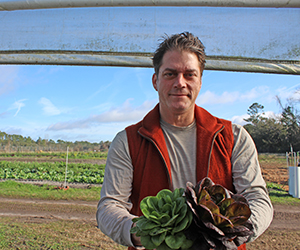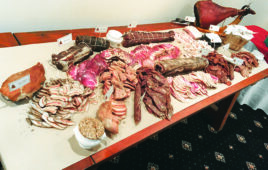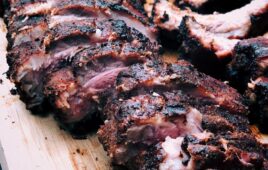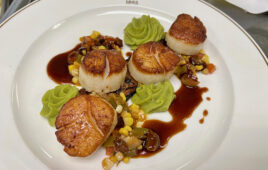
Joe Truex, Executive Chef, The Landings Club
Club chefs are fortifying relationships with vendors who understand their unique needs and can provide the best quality products.
A shorter supply chain doesn’t necessarily mean a less-complicated one. In fact, working with local, smaller or boutique producers and suppliers can bring a whole new set of challenges. Even so, club chefs are committed to sourcing the best quality products for their menus and their members.
“It’s so important to take the time to meet with your suppliers and see how they grow, catch, create or slaughter their products,” says John Farnsworth, Executive Chef of John’s Island Club, Vero Beach, Fla. “Develop a relationship with the people who are most passionate about what they do, so you know what they can provide, and they know what your club wants and expects.”
Last year, John’s Island launched a six-part video documentary series, “Sourced,” to illustrate to its members the complete process of how local ingredients are sourced, prepared and featured on the club’s menus (see “Source of Pride”). The award-winning series (and really the success of the John’s Island F&B operation) wouldn’t have been possible without the decades of relationship-building between Farnsworth and his suppliers.
“We respect what they do, and we’re strong supporters of their work,” says Farnsworth. “Sometimes this means we pay a premium to get the products we want—but I believe that quality is most important.
“Our tomatoes are a perfect example,” he adds. “The difference between a tomato ripened in a shed and a tomato ripened on the vine are worlds apart. We ask our farmer to go through the plant and pick the ones by hand that are ripe. We understand that it might cost us more, but we’re willing to pay for that level of care, because of the quality of the end product.
“In return, our farmers are willing to take bigger risks and grow specific products for us, because they know we’re reliable customers,” Farnsworth says.
One of John’s Island’s farmers is in the process of growing haricot vert specifically for the club. “We usually have to source this item from central America,” says Farnsworth. “But because we have such a strong relationship with this particular farmer, he is willing to grow it for us.”
That same farmer is now growing pineapples for the club, too. “It’s ripe on the plant, and it’s as good as anything I’ve had in Hawaii,” says Farnsworth. “The only downside is that it’s June, and I don’t have as much business.”
The Farnsworth Filet
Farnsworth’s relationship with his seafood supplier offers another great example of the impact that a dynamic relationship between a club chef and purveyor can have on a final dish.
John Farnsworth, Executive Chef of John’s Island Club (pictured far left), has spent years developing relationships with companies like Pelican Seafood, which are run by individuals who are passionate about what they do, so he knows what they can provide, and they know what he wants and expects in return.
“I purchase very specific pompano filets from our seafood supplier, who goes to the dock daily and sorts the catch,” he says. “They have to be clean-cut, skinless, 6-oz. net, finished filets with no pin-bones.
“Our supplier sources the highest-quality fish, cleans it, cuts it and ships it,” says Farnsworth. “It’s a seamless process that allows us to create a spectacular dish for our members.”
These relationships can also dictate menus for Farnsworth.
“I get a fax six mornings a week detailing the latest catch,” he says. “I build my seafood menu around those available products.”
In the height of its busy season, John’s Island will do 3,000 covers in one day. It’s a $6 million F&B operation, and Farnsworth runs a 42% food cost.
“If you manage your product, you can afford to pay for quality and freshness,” says Farnsworth. “It will all fall into place. Look in your kitchen, see what’s going into the trash. Have your people learn what to save and what not to save.”
When Bigger Isn’t Better
When an operation as large as John’s Island Club or The Landings Club in Savannah, Ga., ($12 million) wants to buy a specific ingredient from a smaller farmer, quantity can be a challenge. Finding the best balance between broadliners and smaller producers is key.
“Quite frankly, we can’t feed everyone all local products all the time,” says Joe Truex, one of two Executive Chefs at The Landings Club. “It’s not practical or sustainable. Instead, we feature local and organic ingredients in a way that highlights the farmer and the product.”
The diversity of club menus works in Truex’s favor. “We’re run a lot of volume and we have a lot of flexibility with four clubhouses and all of our menus,” he says. “We aren’t pigeon-holed into needing any one specific product, like a one-off restaurant might be.”
This allows Truex to purchase a variety of products from many different farmers and suppliers, including Bethesda Academy Farm.
This flexibility will be especially important in the coming year, as The Landings Club is in the process of rebranding each of its four clubhouses, to give the dining operations inside them their own unique identities.
Turning Over a New…
The Landings Club will also draw attention to its sourcing efforts with its latest wellness initiative called L.E.A.F. (Life Extension and Fulfillment), which encompasses the many facets of whole person well-being.
“LEAF will include designated dishes that feature organic, local, and especially healthy ingredients,” says Truex. “This program will give us an opportunity to really showcase what we’re doing with local farmers.”
The biggest challenge, according to Truex, will be Mother Nature.
“A freeze, a swarm of bugs or a flood can wipe out a whole season’s crop,” he says. “But that’s the nature of organics and local farmer-based relationships. In the end, it’s well worth it to continue to source locally and supplement conventionally. It’s better for the earth, for your members, and for the local economy.”
When and Where to Offer Organics
J. Kevin Walker, CMC, the newly appointed Executive Chef of Ansley Golf Club in Atlanta, Ga., believes in local sourcing just as much as Truex and Farnsworth. He also believes there is a place in clubs for organic, hormone- and antibiotic-free options.
“We are in the process of building an organic kids menu at the pool,” says Walker. “Right now we offer organic milk, broccoli and chicken, but those options will continue to grow and expand in response to member requests.”
Walker is also in the process of instituting a hormone-free, antibiotic-free protein program that encompasses chicken, beef, pork and lamb.
“Quality comes first,” says Walker, who adds that these initiatives aren’t without challenges.
Cost is the first hurdle, as organics are generally more expensive. Storage is the second.
“Let’s say we offer organic carrots in a la carte, but we run banquet out of that same kitchen,” says Walker. “We now have to store and separate the conventional carrots from the organic ones, as it would be extremely cost-prohibitive to do organic carrots in catering. For this reason, I don’t see us ever going fully organic, but we will look to do more in a la carte.”
The third challenge is delivery.
“Smaller farms can’t always meet delivery schedules,” says Walker. “It comes down to mutual service, though. If they take care of us, we’ll take care of them.
“I’m not going to abandon one of my farmers who has helped me in a pinch because someone else offers to save me money on a certain product,” he adds. “That relationship that we’ve established is far more important. My response to that person trying to undercut my guy is simply that I’ve been doing business with a different company for nine years. I expect them to be loyal to me, just as I am loyal to them.”
When a Garden is a Symbol for More
“This garden is a conversation piece that allows us to showcase how important it is to source quality products.” -Matt Hinkle, Executive Chef,
Exmoor Country Club
For Matt Hinkle, Executive Chef of Exmoor Country Club, Highland Park, Ill., sourcing local just took on a whole new meaning, as the club recently built a 28’ by 32’ organic garden. It cost about $12,000, is managed by a local organic gardening expert, and features five separate beds that are growing herbs, tomatoes, radishes, lettuces, cardoons and more.
“I always try to source as locally as possible,” says Hinkle. “It can be a challenge in Northern Illinois, because our growing season is only four or five months. But this garden is a conversation piece that allows us to showcase how important it is to source quality products.
“When I can pull a head of lettuce directly out of the ground and put it on my members’ plates, the quality and freshness can’t be beat,” continues Hinkle. “We have worked really hard to build relationships with local farmers and suppliers, because offering our members food with integrity is the foundation of our culinary program.”
Why Bother with So Many Suppliers?It would be incredibly simple for these club chefs to source nearly all of their needed ingredients from one conventional broadliner. Yet more and more club chefs are moving away from that approach. Why? “Having a safe food source is important to our members—it’s also important to me as a chef,” says J. Kevin Walker, CMC, Executive Chef of Ansley Golf Club (Atlanta, Ga.). “You can’t tell me the stuff we’re spraying on our food to get strawberries in December isn’t impacting our health. “Our job as a culinary team is to feed our members, but it’s also to nourish them,” Walker continues. “They are always going to want a burger—but we have a responsibility to serve them a beef patty that’s grass-fed and hormone- and antibiotic-free. We must care for the quality of the ingredients, just as we care for them.” “I could very easily buy from one place,” says Matt Hinkle, Executive Chef of Exmoor Country Club, Highland Park, Ill. “But any chef with a shred of honesty will tell you that different companies do different things very well. I will give my business to each of those outfits, because I know that I’m getting the best of the best.” |




